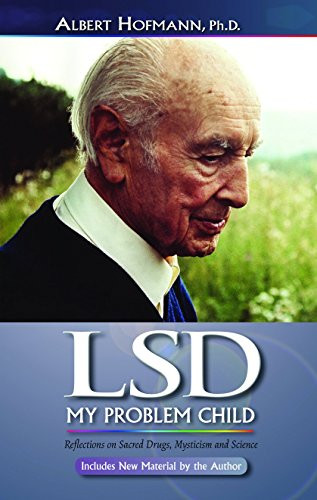[ Home ] [ Controlled Substances ] [ Hallucinogens ]
PSILOCYBIN
|
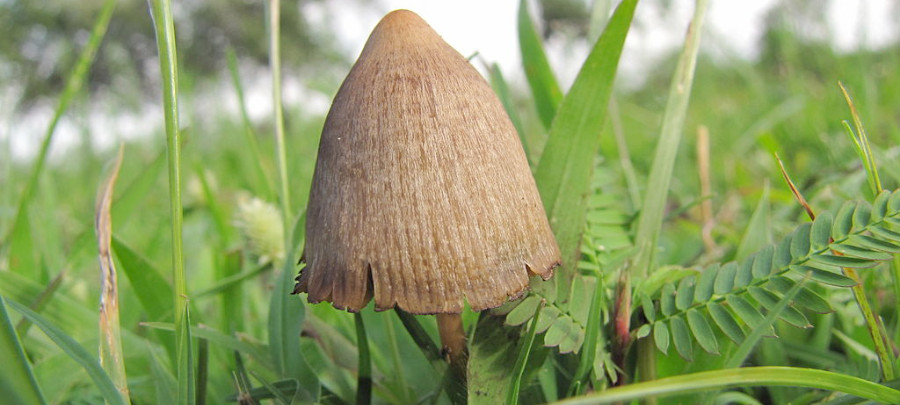
Psilocybin
Psilocybin mushrooms are fungi that contain the psychoactive compound psilocybin, a naturally occurring psychedelic compound capable of producing powerful hallucinations and mystical-type experiences, along with other effects. Psilocybin is more commonly known as "magic mushrooms" or "shrooms." More than 180 species of mushrooms contain psilocybin or its derivative psilocin, and the fungi have a long history of use in Mesoamerican spiritual and religious rituals. They're also one of the most popular and commonly used psychedelics in the U.S. and Europe.
Psilocybin mushrooms are more than just a drug and sacrament, however. They've been used in therapeutic settings to treat a variety of ailments and disorders including cluster headaches, obsessive-compulsive disorders, anxiety, depression, post-traumatic stress disorder, and addiction, and a recent resurgence in research into psilocybin's therapeutic effects is showing promising results.
While psilocybin mushrooms have been decriminalized in three North American cities (see "Legality" for details), they are still illegal at the federal level and are categorized as a Schedule I controlled substance in the U.S. Recently, however, the Food and Drug Administration (FDA) and the Drug Enforcement Agency (DEA) have allowed several small, highly controlled human studies on their potential for use in medical and psychiatric settings. The FDA also designated psilocybin as a "breakthrough therapy" for depression, which could accelerate the process of psilocybin drug development and review.

https://thethirdwave.co/psychedelics/shrooms/
Methods of Psilocybin Use:
"Magic Mushrooms" have long, slender stems which may appear white or greyish topped by caps with dark gills on the underside. Dried mushrooms are usually a reddish rust brown color with isolated areas of off-white. Mushrooms are ingested orally and may be made into a tea or mixed into other foods. The mushrooms may be used as fresh or dried product. Psilocybin has a bitter, unpalatable taste.
A "bad trip", or a unpleasant or even terrifying experience, may occur with any dose of psilocybin. In general, dried mushrooms contain about 0.2% to 0.4% psilocybin and only trace amounts of psilocin. The typical dose of psilocybin used for recreational purposes varies, with peak effects occurring in 1 to 2 hours, and lasting for about six hours.
Dose and effects can vary considerably depending upon mushroom type, method of preparation, and tolerance of the individual. It can be difficult to determine the exact species of mushroom or how much hallucinogen each mushroom contains. Initial smaller doses and a longer period of time to determine the effects may be a safer option if you choose to use psilocybin for recreational purposes.

https://www.drugs.com/illicit/psilocybin.html
Psilocybin is a chemical obtained from certain types of fresh or dried mushrooms. Psilocybin mushrooms are found in Mexico, Central America, and the United States. Mushrooms containing psilocybin are available fresh or dried and have long, slender stems topped by caps with dark gills on the underside. Fresh mushrooms have white or whitish gray stems; the caps are dark brown around the edges and light brown or white in the center. Dried mushrooms are usually rusty brown with isolated areas of off white.
Taken orally. They may also be brewed as a tea or added to other foods to mask their bitter flavor. The psychological consequences of psilocybin use include hallucinations and an inability to discern fantasy from reality. Panic reactions and psychosis also may occur, particularly if a user ingests a large dose. Can also lead to poisoning if one of the many varieties of poisonous mushrooms is incorrectly identified as a psilocybin mushroom. Psilocybin effects are similar to other hallucinogens, such as mescaline and peyote.


https://www.dea.gov/sites/default/files/2018-06/drug_of_abuse.pdf#page=72


https://www.getsmartaboutdrugs.gov/sites/getsmartaboutdrugs.com/files/files/Psilocybin-2020.pdf
Magic Mushrooms Factsheet:
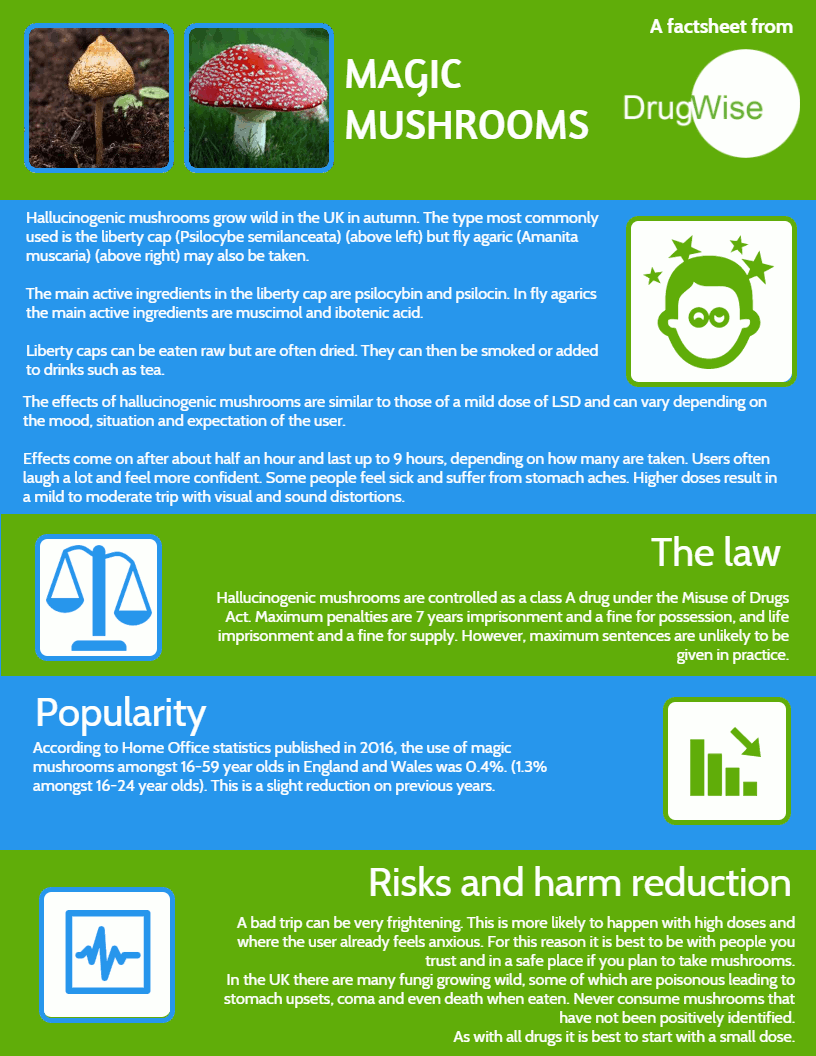

https://www.drugwise.org.uk/magic-mushrooms/
Fast facts on psilocybin:
Psilocybin is a hallucinogenic substance people ingest from certain types of mushroom that grow in regions of Europe, South America, Mexico, and the United States.
The mushrooms containing psilocybin are known as magic mushrooms.
- Psilocybin has both positive and negative physical and psychological effects.
- Psilocybin is not naturally addictive.
- The drug can trigger psychotic episodes.
- Individuals with a family history of schizophrenia or early onset mental illness face an increased risk of an adverse psychiatric reaction to psilocybin.
Psilocybin is a natural hallucinogen:
- Psilocybin is a hallucinogen that works by activating serotonin receptors, most often in the prefrontal cortex. This part of the brain affects mood, cognition, and perception.
- Hallucinogens work in other regions of the brain that regulate arousal and panic responses. Psilocybin does not always cause active visual or auditory hallucinations. Instead, it distorts how some people that use the drug perceive objects and people already in their environment.
- The quantity of the drug, past experiences, and expectations of how the experience will take shape can all impact the effects of psilocybin.
- After the gut ingests and absorbs psilocybin, the body converts it to psilocyn. The hallucinogenic effects of psilocybin usually occur within 30 minutes of ingestion and last between 4 and 6 hours.
In some individuals, the changes in sensory perception and thought patterns can last for several days.

https://www.medicalnewstoday.com/articles/308850
What are the effects?
- At low doses, magic mushrooms produce feelings of relaxation, similar to cannabis.
- At higher doses, colors appear sharper, moving objects leave "trails" behind them and flat surfaces may appear to "breathe." Imaginary visions may begin to appear, as well as feelings of euphoria.
- Users often report laughing a lot and finding things funnier than they would normally.
- A mushroom "trip" tends to last about four to five hours.
- Many people say the mushroom experience is more "earthy" than other psychedelics, increasing emotional awareness and causing less psychological confusion.
Be Careful!
- The greatest danger associated with taking magic mushrooms is accidentally ingesting poisonous mushrooms instead. There are about 200 species of edible, magic mushrooms, but only a handful of these are common. Learn how to identify them and always buy from a known, trusted source.
- Magic mushrooms may precipitate the onset of schizophrenia in genetically predisposed individuals.
- Mushroom trips can sometimes be frightening, inducing extreme anxiety and panic. Although rare, some people relive the experience days, weeks or even years later in episodes known as "flashbacks." Flashbacks are not unique to hallucinogenic drugs. They can result from any intense, psychological trauma.
- Magic mushrooms can impair judgment. Never drive while under the influence of magic mushrooms.
- Magic mushrooms are illegal. Possession can result in long prison terms. Supplying mushrooms to someone else (whether or not money was exchanged) and growing mushrooms (even for personal use) can carry even longer sentences.

https://dancesafe.org/magic-mushrooms/
Physical effects:
Taking magic mushrooms can produce:
- Numbness, particularly in the face
- Increased heart rate and blood pressure
- Dry mouth, sometimes leading to nausea and vomiting
- Muscle weakness and twitching, or convulsions
- Exaggerated reflexes
- Sweating and high body temperature, often followed by chills and shivering
- Loss of urinary control

https://www.canada.ca/en/health-canada/services/substance-use/controlled-illegal-drugs/magic-mushrooms.html
Long-term effects:
Some people who regularly use magic mushrooms may experience flashbacks. A flashback is when a magic mushroom experience reoccurs, they are usually visual distortions that involve perceptual or emotional changes. Flashbacks can occur weeks, months or even years after the drug was last taken. This can be disturbing, especially if a frightening experience or hallucination is recalled. Flashbacks can be brought on by using other drugs, stress, tiredness or exercise and usually last for a minute or two.
Using mushrooms with other drugs:
- Magic mushrooms + ice, speed or ecstasy: Can increase the chances of a bad trip and can also lead to panic.
- Magic mushrooms + some psychiatric medications: Mushrooms should not be taken by people on psychiatric medications as a relapse or worsening of the condition could occur.

https://adf.org.au/drug-facts/psilocybin/


https://cdn.adf.org.au/media/documents/Psilocybin-magic-mushrooms-drug-facts.pdf
First isolated in 1958:
Although certain cultures have known to use the hallucinogenic properties of some mushrooms for centuries, psilocybin was first isolated in 1958 by Dr. Albert Hofmann, who also discovered lysergic acid diethylamide (LSD).
How to Recognize Shrooms
Mushrooms containing psilocybin look liked dried ordinary mushrooms with long, slender stems that are whitish-gray and dark brown caps with light brown or white in the center. Dried mushrooms are rusty brown with isolated areas of off-white.
Magic mushrooms are often prepared by drying and are eaten by being mixed into food or drinks, although some people eat freshly picked magic mushrooms.
Magic mushrooms can be eaten, mixed with food, or brewed like tea for drinking. They can also be mixed with cannabis or tobacco and smoked. Liquid psilocybin is also available, which is the naturally occurring psychedelic drug found in liberty caps. The liquid is clear brown and comes in a small vial.
Common Side Effects:
Magic mushrooms are known to cause:
- Nausea
- Yawning
- Feeling relaxed or drowsy
- Introspective experience
- Nervousness
- Paranoia
- Panic
- Hallucinations
- Psychosis

https://www.verywellmind.com/what-are-magic-mushrooms-22085
What is psilocybin?
Psilocybin and psilocin are chemical compounds obtained from certain types of dried or fresh hallucinogenic mushrooms found in Mexico, Central America and the United States. These compounds have similar structure to lysergic acid diethylamide (LSD). There are over 180 species of mushrooms that contain the chemicals psilocybin or psilocin. Like the peyote, hallucinogenic mushrooms have been used in native rites for centuries. Both psilocybin and psilocin can also be produced synthetically in the lab.
Why do people use psilocybin?
Mushrooms have been taken in religious rituals in indigenous cultures in Mexico and Central America for thousands of years. Today, recreational users take them to induce mild euphoria, tingling physical sensations, increased sensitivity to music, and visual sensations. They are considered by many to be a more gentle or natural hallucinogen in comparison to other, more aggressive chemical hallucinogens such as Ketamine and LSD.
How is psilocybin used?
Usually taken orally, psilocybin is found in dried or fresh mushrooms or as a powder in capsules. It is also sometimes brewed into a tea. Typical doses range from 10 to 50 milligrams (approximately 20 to 30 grams of fresh mushrooms or 1 to 2.5 grams of dried mushroom powder) and the effects usually take 1 to 2 hours to start and typically last for about 6 hours. However, dosages may vary because psilocybin concentrations differ widely according to the genus, strength, and condition (fresh or dried) of the mushrooms.
How many people use psilocybin mushrooms?
Psilocybin mushrooms are considered one of the most well-known psychedelics, but according to the Substance Abuse and Mental Health Services Administration (SAMHSA), which conducts the largest annual national survey on drug use, their use is not at all common.Psychedelic use is so low that several drugs are grouped under the category of hallucinogens, which includes LSD, peyote, mescaline, psilocybin mushrooms, and Ecstasy or Molly (MDMA).
In each year between 2002 and 2014, an annual average of 0.1% of people across all ages were considered to be current psychedelic users (meaning they reported use within 30 days of completing the survey). In 2014, 0.3% of the 16,875 adolescent respondents (12 to 17 year-olds) in the US were considered to be current users of psychedelics, 0.3% of the 11,643 young adult respondents (18 to 25), and 0.1% of 33,750 adult respondents aged 26 or older.
However, from 2004 - 2005 (the last year data for this specific question were available), around half of the people who reported trying a psychedelic for the first time used psilocybin mushrooms (out of approximately 67,000 respondents).
Data from people reporting lifetime use of psychedelics shows similar rates across most age ranges, meaning just as many young adults in the 21st century have used psychedelics as older adults who lived through the 1960s and 70s.
 10 Facts about Psilocybin Mushrooms:
10 Facts about Psilocybin Mushrooms:
https://drugpolicy.org/drug-facts/psilocybin-mushrooms
Psilocybin is a naturally occurring psychedelic prodrug compound produced by more than 200 species of mushrooms, collectively known as psilocybin mushrooms. Once ingested, psilocybin is rapidly metabolized to the psilocin, which then acts on serotonin receptors in the brain. Psilocybin was identified as the active hallucinogenic compound in magic mushrooms in 1959, but humans have used assorted psilocybin mushrooms in religious ceremonies since prehistoric times. In the 1960's psilocybin was marketed for use as a treatment for various psychoses, however, it was withdrawn from the market when the regulatory environment changed. Recently there has been as renewed interest in studying the medicinal uses of psilocybin for treatment of anxiety, depression, migraine headaches, addictions, and other neuropsychiatric conditions.
 Psilocybin:
Psilocybin:
https://drugs.ncats.io/drug/2RV7212BP0
Beginnings:
The first use of hallucinogenic mushrooms dates back about 3,000 years to Mexico. They are still used by native people in some areas for religious ceremonies and healing, although the local communities encountered many struggles in the past. Shortly after the European conquest of these territories, magic mushrooms were banned for the first time in the early 17th century. A couple of centuries passed before these mushrooms gained the attention of Western scientists and doctors for the first time.Robert Wasson, an American ethnomycologist, popularized these mushrooms in the 50s after returning from an expedition to Mexico where he participated in an indigenous Mazatec religious ritual. He was one of the first Westerners to participate in such a ritual. He published an article in the Life magazine called "Seeking The Magic Mushroom" in which he described his experience. The article became extremely popular, especially in the counterculture movement of the time, and led many people to travel Mexico seeking to experience the same. But this only brought devastation and unwanted attention from foreigners and police to the local community.
Luckily, it also brought some attention from the scientific community. Psilocybin was first isolated, identified, and synthesized by Albert Hofmann, the "father of LSD", in the late 50s (from P. mexicana). He later summarized his thoughts about psychedelics, including LSD and psilocybin, in the book "LSD - My Problem Child"
It didn't take long for psilocybin to become popular among the general public as a recreational drug.
The name of the band "The Doors" was inspired by Aldous Huxley's book "The Doors of Perception", in which he describes his own theories and experiences with psychedelics.

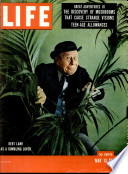 Google Books Life Magazine (May 13, 1957):
Google Books Life Magazine (May 13, 1957):
https://books.google.com/books/about/LIFE.html?id=Jj8EAAAAMBAJ
 Psilocybin: Safety, Side Effects & Types of Mushrooms:
Psilocybin: Safety, Side Effects & Types of Mushrooms:
https://selfhacked.com/blog/psilocybin/
History:
There are more than 100 species of psilocybin mushrooms worldwide, with samples found everywhere from Latin and North America to Europe and Asia. Given this geographic distribution, it is unsurprising that various cultures throughout history have incorporated their use into ceremonial and religious practices. For instance, the Aztecs reportedly served a Psilocybe species known as teonanacatl - the "divine mushroom" - at the coronation of Emperor Motecuhzoma Xocoyotzin. In Spain, artwork depicting Psilocybe hispanica has led researchers to hypothesize that the ritual use of magic mushrooms may have begun in Europe as early as 4000BC.Some, like Terrence McKenna, have gone as far as to propound the Stoned Ape Hypothesis, which asserts that our long-term use of psilocybin mushrooms in prehistoric times led to epigenetic changes that were responsible for rapid increases in intelligence.
While most academics are sceptical of such claims, there is little doubt that psilocybin mushrooms have an extensive history of influencing human behaviour.After becoming an essential part of the US countercultural movement in the 1960s, public opinion on psilocybin and other psychedelics began to shift by the middle of the decade - in no small part due to a PR campaign by the US Government - culminating in their prohibition. The golden age of psychedelic research (1950-1965), wherein more than a thousand scientific papers were published, had come to an end. Upon psilocybin's reclassification as a Schedule I substance in 1970, research largely ground to a halt until after the turn of the century, when researchers at the University of Arizona discovered that psilocybin was associated with acute reductions in obsessive-compulsive disorder (OCD) symptoms. Since then, research has picked up pace.
 Psilocybin:
Psilocybin:
https://www.atai.life/programs/psilocybin/
Modern History:
In the late 1950s, Albert Hofmann, the Swiss chemist who "discovered" LSD mostly by accident, started experimenting with something even more powerful: magic mushrooms.Indigenous people in Mexico had been observed using mushrooms in religious rituals by western visitors several years earlier. One of the interlopers sent a sample to Hofmann, who became the first western scientist to identify, isolate, and artificially synthesize the active ingredients, compounds called psilocybin and psilocin.
Recognizing the medical value of the mushrooms, Hofmann's employer, the pharmaceutical giant Sandoz, soon packaged them into a pill and started marketing a drug called Indocybin. Therapists and researchers were thrilled. Here was a safe pharmaceutical drug, with immense potential to treat a wide range of mental-health pathologies, including depression and addiction!
But then the drug war happened. Psilocybin was classified as a Schedule I drug in 1970. Research, as well as treatment, halted. Indocybin disappeared from pharmacists' shelves and from therapists' arsenals. Novartis, Sandoz's parent company, does not even mention Indocybin in its company history.
Since that point, progress in understanding psilocybin and its therapeutic potential has been mostly frozen in time. Now, the intense interest in psilocybin as a therapy tool and the popular pushes to legalize magic mushrooms are best understood as a "rediscovery," as well as a reminder of how much research and progress was destroyed by the drug war. Psilocybin knowledge is in many ways a time capsule dating back to the 1960s.
 (2020 Article) New Magic Mushrooms Could Fix Depression, Addiction, Epilepsy, and More:
(2020 Article) New Magic Mushrooms Could Fix Depression, Addiction, Epilepsy, and More:
https://observer.com/2020/12/new-magic-mushrooms-psilocybin-cure-depression/
Psychedelic trips:
Highly variable and difficult to describe, but typical features include distorted perception or hallucinations, an altered sense of space and time and a loss of the normal boundaries of personhood, often accompanied by euphoria. Despite its powerful effects on the mind, psilocybin has almost no physical toxicity in the body and is unlikely to cause harm or addiction. Brain imaging studies show that psilocybin decreases blood flow as well as connectivity between important areas of the brain that control perception and cognition. Psilocybin is being investigated as a possible treatment for mental illness, including anxiety related to advanced cancer and depression. Small studies suggest that a single dose of psilocybin can lead to long-term reductions in depression symptoms, perhaps by interrupting patterns of negative thoughts and allowing the brain to remodel itself.
Several larger trials are now under way:
In 2018, the US Food and Drug Administration (FDA) gave psilocybin a "Breakthrough Therapy" designation, indicating that the therapy is considered highly promising and will receive support from the FDA to accelerate the approval process. Psilocybin is illegal in most of the world, but two US cities, Denver and Oakland, voted to stop law enforcement agencies from targeting psilocybin users in 2019, effectively decriminalising it. Psychedelic truffles containing psilocybin can be bought legally in the Netherlands.

https://www.newscientist.com/term/psilocybin/
Where is psilocybin legal?
Psilocybin itself is a prohibited substance in most countries. However, in some countries it is legal to possess, grow, or even sell psilocybin mushrooms.
- In Brazil, there are no specific laws against the possession or consumption of psilocybin mushrooms, and use of magic mushrooms could even be covered under laws protecting the sacramental use of substances.
- The British Virgin Islands prohibit the sale of magic mushrooms, but allow for possession and consumption. You will often find vendors selling mushroom shakes without apparent fear of prosecution.
- In Jamaica, the authorities appear to turn a blind eye to psilocybin mushrooms, allowing its use in commercial retreats and for private personal use.
- The Netherlands is a unique case: psilocybin mushrooms are illegal, but psilocybin truffles are legal. Truffles are just an earlier stage of mushroom development, and still contain psilocybin at high levels.

https://www.synthesisretreat.com/psilocybin
Measure 109:
Oregon becomes 1st state to legalize psilocybin for mental health therapy. Measure 109 creates a program that allows licensed, supervised facilities to manufacture, deliver and administer psilocybin under regulations that are established and enforced by the Oregon Health Authority (OHA). In other words, psilocybin will not be sold in stores and people won't be allowed to take the drug home. It will only be available within a regulated psilocybin service center.

https://www.kgw.com/article/news/politics/elections/oregon-becomes-1st-state-to-legalize-psilocybin-for-mental-health-therapy/283-4103d1ba-9d9a-4dc0-9970-6f8cc1288323
The state of psilocybin research (2019):
From treating depression to helping manage alcohol addiction, researchers say legal medical "magic mushrooms" have many potential benefits.
Psilocybin may have many potential benefits, but none have yet to be approved by the FDA.
Psilocybin, the active ingredient found in "magic" mushrooms, or "shrooms," is a powerful psychedelic. Despite being about 100 times less potent than LSD, it's capable of altering perception of space and time, causing visual distortions, euphoria, and mystical experiences. Unlike marijuana, which has seen a dramatic shift both in terms of support of legalization and recognized therapeutic uses, or MDMA, which has grabbed headlines in recent years for its potential to treat PTSD (some researchers believe the drug could see Food and Drug Administration approval as soon as 2021), psilocybin lacks the same degree of cultural cachet. And one could be forgiven for thinking of "shrooms" as nothing more than a remnant of the excess of the psychedelic 1960s.But make no mistake: Psilocybin has a number of potential medical benefits.
Its potential indications include depression, obsessive-compulsive disorder, quitting smoking, alcohol addiction, cocaine addiction, cluster headaches, and cancer-related or other end-of-life psychological distress.
Will psilocybin ever be approved by the FDA?
- "It will only be administered in a clinic by specially trained and certified therapists, physicians. It's never gonna be available out on the street where people can sell it or take too much, or take too many of their pills from a prescription," Greer said.
- Psilocybin affects the cardiovascular system and can lead to increased blood pressure or irregular heartbeat.
- It also has the potential to cause serious and permanent psychological problems. Psilocybin is a lot more psychologically dangerous than cannabis. And there's always the chance of a bad trip

https://www.healthline.com/health-news/benefits-of-medical-mushrooms
The chemical works by binding the same receptors in the brain as the neurotransmitter serotonin. This allows the drug to alter mood. While many people have a happy, meaningful experience, some can have a "bad trip" and experience extreme paranoia Prior studies have found that that getting high on psilocybin doesn't just create a colorful, psychedelic experience for a couple of hours; it can cause neurological changes that last over a year. These changes resulted in a personality that was more open to the creative arts and became happier, even 14 months after receiving the psilocybin. Though previous research surmised that psilocybin decreased brain activity, the current study used functional magnetic resonance imaging (fMRI) to see what was really going on.
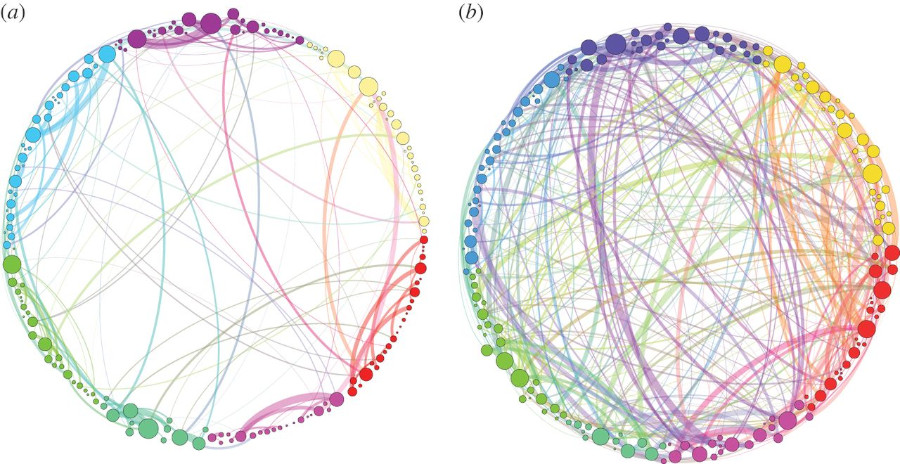
Simplified illustration of the connections tracked while receiving the placebo (a) and the psilocybin (b)
Surprisingly, the researchers saw that upon receiving psilocybin, the brain actually re-organized connections and linked previously unconnected regions of the brain. These connections were not random, but appeared very organized and stable. Once the drug wore off, the connections returned to normal.
"We can speculate on the implications of such an organization. One possible by-product of this greater communication across the whole brain is the phenomenon of synesthesia which is often reported in conjunction with the psychedelic state,"
The mechanism of how psilocybin is creating these changes is not yet known and will require further study. The researchers believe that in understanding the drug's mechanism for temporarily re-wiring the brain and altering mood, it could potentially be manipulated into making a functional treatment for depression or other disorders. However, there is much more to be learned before it can be used in that manner.

https://www.iflscience.com/brain/magic-mushroom-chemical-hyper-connects-brain/
(Study) Adults with Major Depression:
The antidepressant effect of the psilocybin - the active compound in so-called magic mushrooms - was about four times greater than is typically seen in traditional antidepressants currently on the market. In a small study of adults with major depression, Johns Hopkins Medicine researchers report that two doses of the psychedelic substance psilocybin, given with supportive psychotherapy, produced rapid and large reductions in depressive symptoms, with most participants showing improvement and half of study participants achieving remission through the four-week follow-up.
"Because most other depression treatments take weeks or months to work and may have undesirable effects, this could be a game changer if these findings hold up in future 'gold-standard' placebo-controlled clinical trials." The published findings cover only a four-week follow-up in 24 participants, all of whom underwent two five-hour psilocybin sessions under the direction of the researchers.
The researchers say they will follow the participants for a year after the study to see how long the antidepressant effects of the psilocybin treatment last, and will report their findings in a later publication.

https://hub.jhu.edu/2020/11/11/psilocybin-rapidly-treats-depression/
Psilocybin, the active ingredient in psychoactive mushrooms, has provided the spiritual and cultural bedrock of many great civilisations. The Aztecs referred to teonanacatl, which translates as 'divine mushroom', and modern neuroscience has revealed how psilocybin interacts with serotonin receptors in the brain in order to produce a range of consciousness-altering effects.

https://www.beckleyfoundation.org/science/substances-methods/psilocybin/


https://psyarxiv.com/u6v9y
Physical form:
Hallucinogenic mushrooms are available in fresh form, treated/preserved (e.g. deliberately dried, cooked, frozen) or even as dry powders or capsules. The fungi containing psilocybin and psilocin mainly belong to the genuses Psilocybe, Panaeolus and Copelandia and their number exceeds 50 species. Most of the mushrooms containing psilocybin are small brown or tan mushrooms. In the wild, these mushrooms are easily mistaken for any number of non-psychoactive, inedible, or poisonous mushrooms. This makes them difficult, and potentially hazardous, to identify. Because it is difficult to distinguish non-psilocybin species from the hallucinogenic ones by morphological observation in the wild, psilocybin-containing mushrooms may also be easily ingested unintentionally. Hallucinogenic mushrooms resemble the common store mushroom Agaricus bisporus, although the flesh of Psilocybe mushrooms characteristically turns blue or green when bruised or cut. An identification method based on a genetic approach has been developed.
 Hallucinogenic mushrooms drug profile:
Hallucinogenic mushrooms drug profile:
https://www.emcdda.europa.eu/publications/drug-profiles/hallucinogenic-mushrooms_en
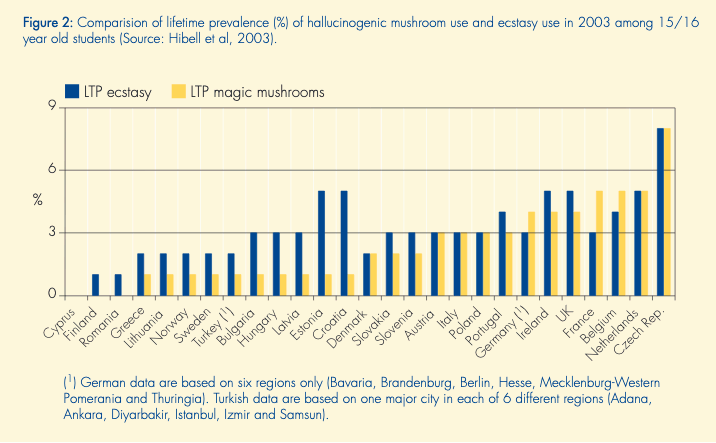

 Hallucinogenic mushrooms: an emerging trend case study (2006) (PDF 33 pages):
Hallucinogenic mushrooms: an emerging trend case study (2006) (PDF 33 pages):
https://www.emcdda.europa.eu/system/files/publications/406/TP_Hallucinogenic_mushrooms_107298.pdfKey issues at a glance:

 Hallucinogenic mushrooms: the challenge of responding to naturally occurring substances in an electronic age (2007) (PDF 4 pages):
Hallucinogenic mushrooms: the challenge of responding to naturally occurring substances in an electronic age (2007) (PDF 4 pages):
https://www.emcdda.europa.eu/system/files/publications/471/Dif15EN_84955.pdf
The Fungi of California:
- 784 species
- 726 descriptions
- 8021 photographs
- 2386 links
http://www.mykoweb.com/CAF/species_index.html

https://mushroomobserver.org/
| Some Types of Psilocybin Mushrooms: |
|---|
| Thank you EntheoNation for the images! |

The Easy Guide On How To Identify Psilocybin Mushrooms: https://entheonation.com/blog/psilocybin-mushrooms-identification/ |
| Psilocybe Semilanceata: |
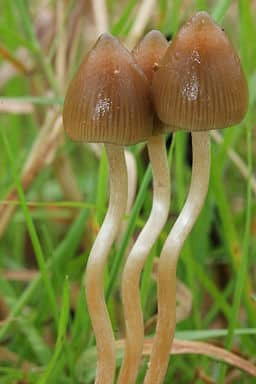 Psilocybe Semilanceata: Known to be among the most potent psilocybin mushrooms.
|
| Psilocybe Mexicana: |
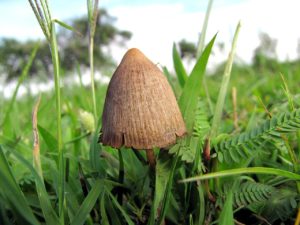 Psilocybe Mexicana:
|
| Psilocybe Cyanescens: |
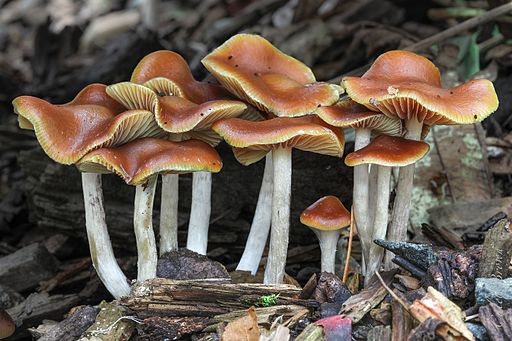 Psilocybe Cyanescens:
|
| Psilocybe Azurescens: |
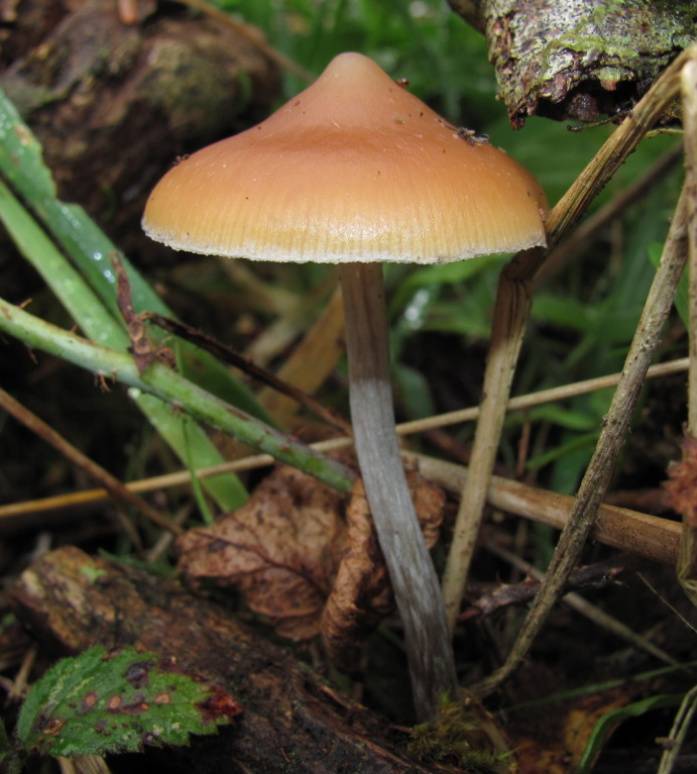 Psilocybe Azurescens:
Also known as the most potent psychoactive psilocybin mushrooms due to the fact that it has the highest concentration of the psychoactive biochemicals, psilocybin and psilocin. (Along with Psilocybe Semilanceata) |
| Psilocybe Baeocystis: |
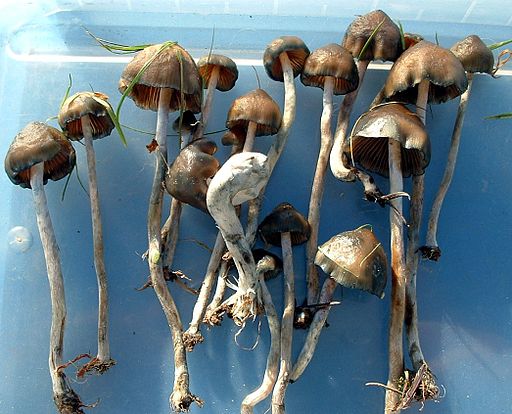 Psilocybe Baeocystis:
|
| Psilocybe Cubensis: |
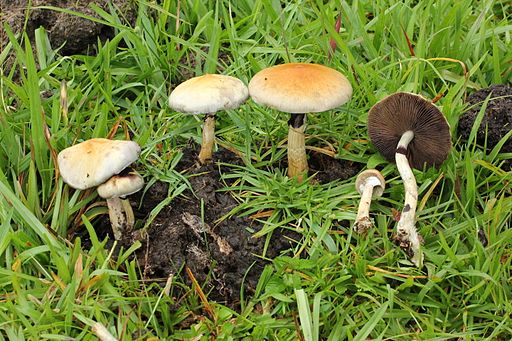 Psilocybe Cubensis: This is the most popular species of psilocybin mushrooms, also known as "Golden Teacher".
|
Consuming wild psilocybin mushrooms can be dangerous.
As psilocybin mushrooms are capable of being harvested in nature, there is a major risk of misidentifying mushroom species and accidentally consuming poisonous varieties. This risk can be avoided by educating oneself in advance on how to properly identify the correct species of mushroom found within one's local area and finding an experienced mentor.

https://psychonautwiki.org/wiki/Psilocybin_mushrooms

https://library.uniteddiversity.coop/Permaculture/Mushroom_Cultivator-A_Practical_Guide_to_Growing_Mushrooms_at_Home.pdf

http://www.en.psilosophy.info/pdf/psilocybin_magic_mushrooms_growers_guide_(psilosophy.info).pdf

https://www.erowid.org/plants/mushrooms/mushrooms.shtml
Erowid Experience Vault Psilocybin:
https://erowid.org/experiences/subs/exp_Psilocybin.shtml
Erowid Experience Vault Mushrooms:
https://erowid.org/experiences/subs/exp_Mushrooms.shtml

https://www.reddit.com/r/PsilocybinMushrooms/
r/Psilocybin:
https://www.reddit.com/r/psilocybin/
r/Shroomery:
https://www.reddit.com/r/shroomery/
r/Shrooms:
https://www.reddit.com/r/shrooms/
r/MagicMushrooms:
https://www.reddit.com/r/MagicMushrooms/

https://www.hipforums.com/forum/forum/114-magic-mushrooms/

https://www.bluelight.org/xf/threads/the-big-dandy-psilocybin-mushrooms-thread.58587/

https://drugs-forum.com/forums/magic-mushrooms-psilocybe-amanita.8/

https://www.shroomery.org/

https://www.shroomology.org/forums/

http://mycotek.org/index.php

https://mycotopia.net/


https://drugpolicy.org/sites/default/files/Psilocybin_Mushrooms_Fact_Sheet.pdf


https://maps.org/research-archive/psilo/psilo_ib.pdf


https://mothertobaby.org/fact-sheets/magic-mushrooms/pdf/


https://www.caymanchem.com/msdss/15695m.pdf
- A naturally occurring psychedelic prodrug compound (quickly converted by the body to psilocin)
- It's produced by more than 200 species of fungus
Imagery found on prehistoric murals and rock paintings of modern-day Spain and Algeria suggests that human usage of psilocybin mushrooms predates recorded history.
- The intensity and duration of the effects of psilocybin are variable, depending on species or cultivar of mushrooms, dosage, individual physiology, and set and setting, as was shown in experiments led by Timothy Leary at Harvard University in the early 1960s.
- The mind-altering effects of psilocybin typically begin 10 - 40 minutes after ingestion and last from two to six hours, although to individuals under the influence of psilocybin, the effects may seem to last much longer, since the drug can distort the perception of time.
- Psilocybin has a low toxicity and a low harm potential.
- Possession of psilocybin-containing mushrooms has been outlawed in most countries, and it has been classified as a scheduled drug by many national drug laws.
- Psilocybin is currently being researched for its effect on depression, anxiety and other psychiatric conditions.
- Both the caps and the stems contain the psychoactive compounds, although the caps consistently contain more.
PSILOCYN
|
Psilocybin is a prodrug of psilocin:
This means the prodrug psilocybin undergoes changes in the body which convert it into the active form, psilocin. Specifically, a chemical process called dephosphorylation removes the phosphate group on psilocybin, creating psilocin. The dephosphorylation of psilocybin occurs in two ways in different areas of the body.
- The acidic environment in the stomach is a favorable environment for the rapid dephosphorylation of psilocybin.
- Enzymes such as alkaline phosphatase and other non-specific esterases dephosphorylate psilocybin in the intestines, kidneys, and the blood.
Psilocin is the Hallucinogen:
Psilocybin itself is actually not psychoactive. Once psilocybin is ingested, it is converted into psilocin, which causes the hallucinations. Alternative methods of psilocybin ingestion that avoid the digestive tract cause no hallucinations at all. Psilocin is particularly interesting because it is structurally similar to serotonin, an important neurotransmitter in the brain, and can bind many of the same receptors. When psilocin binds these receptors it causes many of the hallucinogic effects of mushroom ingestion.

https://massivesci.com/articles/psilocybin-yeast-magic-mushrooms-psychedelics/
Psilocin is a serotonergic psychedelic substance found in most psychedelic mushrooms along with its phosphorylated counterpart psilocybin. Psilocin is the pharmacologically active agent in the body after ingestion of psilocybin. Psilocybin rapidly dephosphorylates to psilocin which acts as a 5-HT2A, 5-HT2C, and 5-HT1A agonist or partial agonist.
 Psilocin:
Psilocin:
https://drugs.ncats.io/drug/CMS88KUW0G
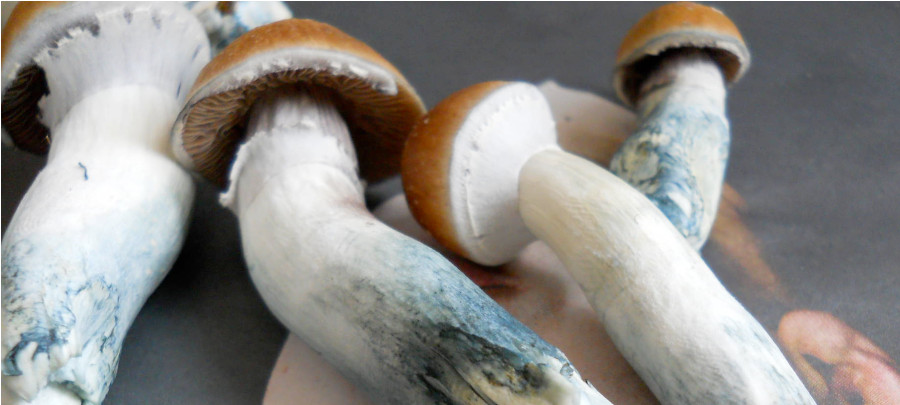
Stained Blue Mushrooms... and Psilocybin
Ever noticed that magic mushrooms stain blue while picking them from your grow kit? The blue color appears because of the substances inside the mushroom oxidize with the air. Which is called bruising. This is your first visual contact with the alkaloid Psilocybin. The other alkaloid in hallucinogenic mushrooms is Psilocin (psilocine).
The degree of bluing in a Psilocybe fruit body roughly correlates with the concentration of psilocin in the mushroom. The blue-er the mushroom the higher the mushroom potency could be. The bruising of the mushroom stem is also one of the identifying facts of magic mushrooms.

https://www.magic-mushrooms-shop.com/en/blog/psilocybe-and-psilocin-in-magic-mushrooms
Psilocin and psilocybin, hallucinogenic principles contained in certain mushrooms, notably the two Mexican species Psilocybe mexicana and P. cubensis (formerly Stropharia cubensis). Hallucinogenic mushrooms used in religious ceremonies by the Indians of Mexico were considered sacred and were called "god's flesh" by the Aztecs. In the 1950s the active principles psilocin and psilocybin were isolated from the Mexican mushrooms. As a result of their subsequent recreational abuse, psilocin and psilocybin and the mushrooms that contain them came under strict regulatory control. Psilocin and psilocybin are not used in modern medicine, but research suggests that they may have potential applications in the treatment of anxiety and in the improvement of quality of life for terminally ill patients. The substances have also been used in human subjects to better understand the effects of hallucinogens on the brain and to investigate various aspects of psychosis, personality, and consciousness.

https://www.britannica.com/science/psilocin

https://erowid.org/experiences/subs/exp_Psilocin.shtml
The effects typically last anywhere from three to eight hours depending on certain variables (such as metabolism, food interaction); however the effects can seem to last much longer due to psilocin's ability to distort the perception of time. Belongs to the class of organic compounds known as tryptamines and derivatives.
 Metabocard for Psilocin:
Metabocard for Psilocin:
https://hmdb.ca/metabolites/HMDB0042000
Psilocybin — the drug in 'magic mushrooms' — could see federal restrictions loosened - 7:09 p.m. Aug. 22, 2025: An earlier version of this story reported that Dr. Sunil Aggarwal filed a lawsuit after a 2020 petition seeking to reschedule psilocybin was denied. He filed that petition in ... Thursday August 21, 2025 - yahoo.com Study: Psilocybin and mindfulness can curb depression, burnout - A new study announced Wednesday shows that psilocybin -- the active compound in "magic mushrooms" -- and mindfulness training can together ease depression. Is there more to magic mushrooms than psilocybin? - Anecdotal reports have suggested that magic mushrooms can have a stronger intensity and different visual effects than synthetic psilocybin. Those reports intrigued Lerer, who set out to conduct some ... Psilocybin Drug By Psilera Could Treat Frontotemporal Dementia Without Psychoactive Effects - Psilera's PSIL-006 had successfully cleared a key safety milestone in preclinical studies, demonstrating a “strong” safety profile. The drug is designed to deliver the therapeutic benefits of ... As psilocybin got more attention, drug busts of the psychedelic drug went up - Craig Mitchelldyer / AP In recent years, there's been growing interest in psilocybin, the psychoactive ingredient in "magic mushrooms" or "shrooms" as a potentially beneficial therapy for mental ... Penn Med researchers find psilocybin can relieve depression, chronic pain with single shot - Penn Medicine researchers have discovered that psilocybin, a natural compound found in some psychedelic mushrooms, can relieve depression and chronic pain with a single dose. Psilocybin-Based Drug Candidate Gains Patent - Ahead of the competition, drug developers are locking in patents while the psychedelic renaissance takes the medical community by storm. Enveric Biosciences, a biotechnology company focusing on the ... Psilocybin Legislation Is Helping Psychedelic Drugs Make a Comeback. Here Are the Challenges They Face - An operations manager finds relief from her depression with the help of psilocybin, the primary psychoactive component of “magic mushrooms.” A veteran conquers his post-traumatic stress disorder ... Littleton company developing psilocybin microdosing drug in hopes of FDA approval - A Littleton company is developing a drug using psilocybin mushrooms that it hopes one day will be offered as a natural – and legal – alternative to traditional antidepressants. AJNA BioSciences is a ... Oregon launches legal psilocybin, known as "magic mushrooms" access to the public - Oregon has taken an unprecedented step in offering psilocybin, also known as magic mushrooms, to the public. Epic Healing Eugene - America's first licensed psilocybin service center - opened in June, ... Psilocybin — the drug in 'magic mushrooms' — could see federal restrictions loosened - Regulation of psilocybin — the “magic” substance in psychedelic mushrooms — has been a hot-button issue for Californians in recent years, but repeated attempts by state lawmakers to allow medical use ...
| ||
| Hallucinogens | Link to this page |




